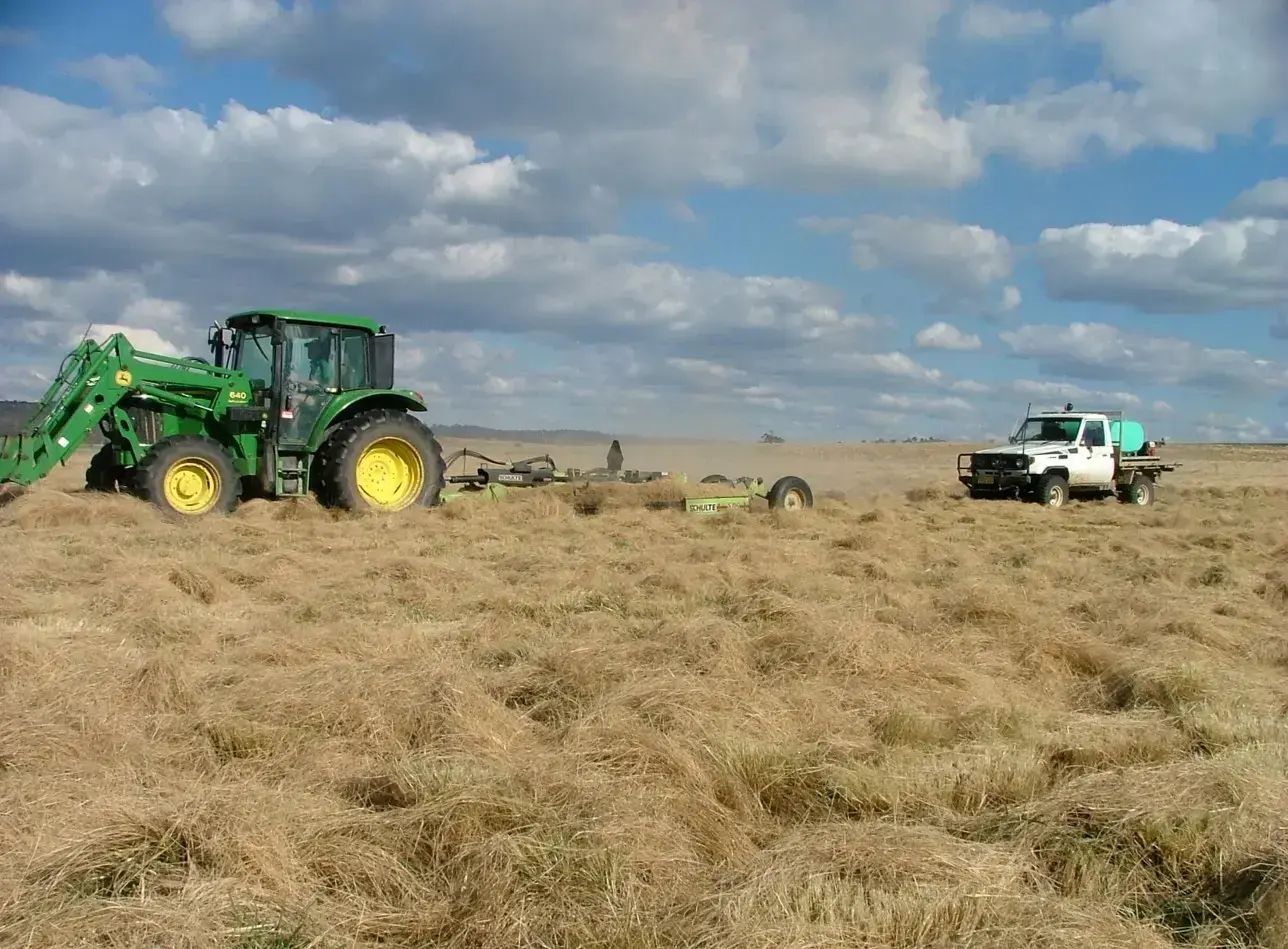‘Shannon Vale Station‘
A REGENERATIVE AGRICULTURE CASE STUDY
 Greg and Sally Chappell have shown that pasture improvement using organic-based fertilisation together with carefully planned stock management can overcome significant weed problems and vastly improve productivity.
Greg and Sally Chappell have shown that pasture improvement using organic-based fertilisation together with carefully planned stock management can overcome significant weed problems and vastly improve productivity.
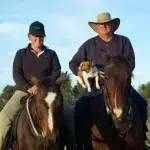 Greg and Sally Chappell have shown that pasture improvement using organic-based fertilisation together with carefully planned stock management can overcome significant weed problems and vastly improve productivity.
Greg and Sally Chappell have shown that pasture improvement using organic-based fertilisation together with carefully planned stock management can overcome significant weed problems and vastly improve productivity.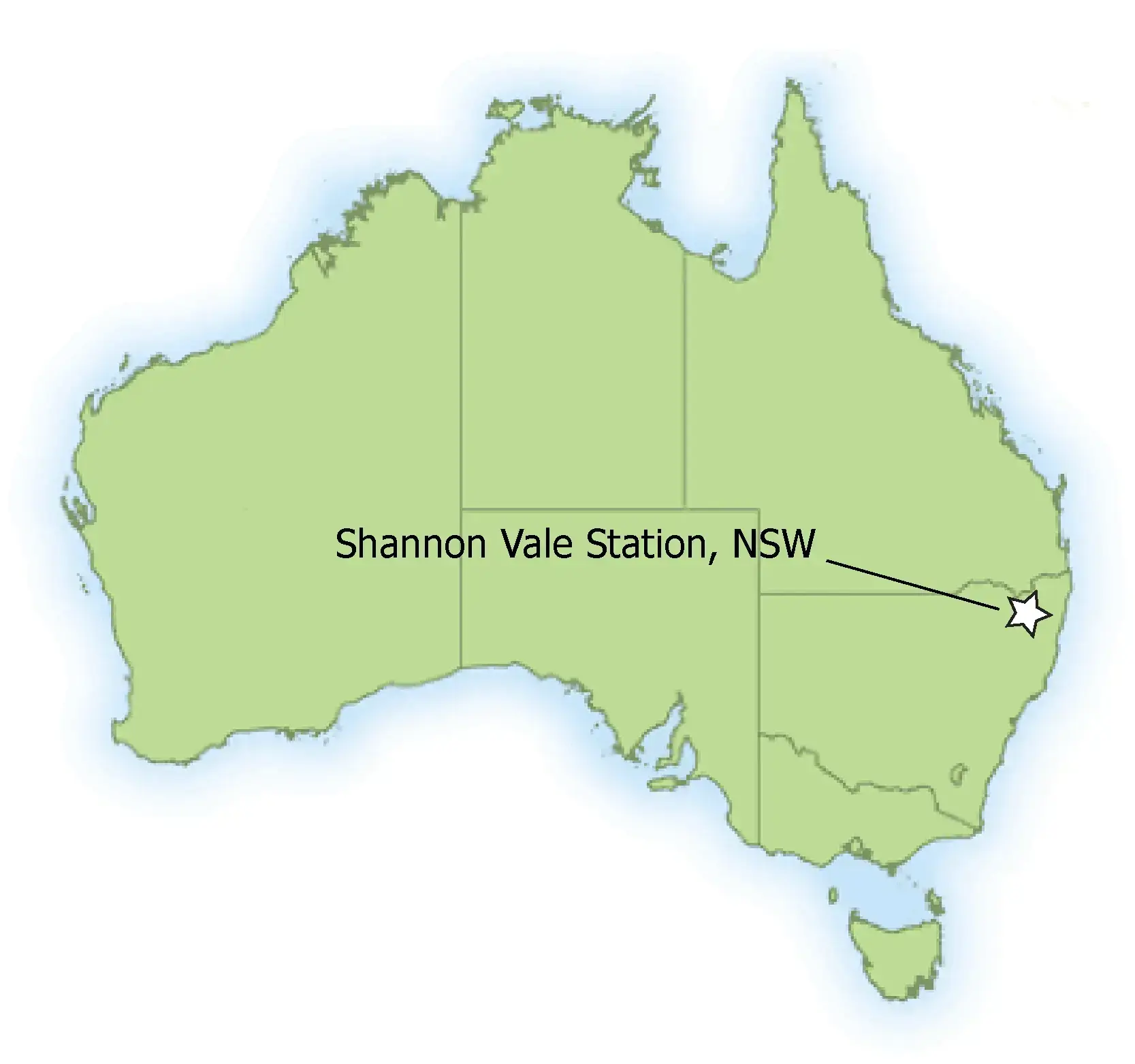
12km east of Glen Innes, NSW Northern Tablelands
FARM FACTS
ENTERPRISE: Cattle. Angus bull breeding from high performance seed stock
PROPERTY SIZE: 1450 hectares
AVERAGE ANNUAL RAINFALL: 750-850 mm
ELEVATION: 1000-1090 m
MOTIVATION FOR CHANGE: Drought, economic viability and gaining a deeper understanding of biological cycles
INNOVATIONS
- Organic fertilisation tailored to soil and plant nutrient requirements
- No cultivation or herbicides
- Managed grazing pressure
- Innovations commenced: 2005
KEY RESULTS
- 30-35% reduction in production costs
- 10% increase in production
- 20% increase in bull and heifer weight gain
- Rejuvenated pastures and weed control
Introduction
Greg Chappell taught agricultural science at the Farrer Memorial Agricultural High School (FMAHS) for 13 years before taking up farming full-time. He and Sally then developed an Angus bull breeding business, initially at Willow Tree. When the business out-grew the farm they moved to a property at Moree and then, in 2001, to Shannon Vale Station. Although he had taught conventional agriculture at FMAHS, Greg’s experience on his original farm at Willow Tree made him realise that conventional methods weren’t sustainable, so he was already beginning to explore other methods of land management when faced with the weed challenge that emerged at Shannon Vale.
Weeds including African lovegrass (Eragrostis curvula), blackberry (Rubus fruticosus), nodding thistle (Carduus nutans), Chilean needle grass (Nassella neesiana), carpet grass (Axonopus spp.), rat’s tail fescue (Vulpia myuros), sorrel (Rumex acetosa) and St Johns wort (Hypericum perforatum) were proliferating under the previous management system at Shannon Vale, badly damaging productivity and profits. Using organic-based fertilisation targeted specifically to address soil nutritional deficiencies, Greg and Sally worked to create an environment that allowed pasture species to re-establish from dormant seed. The Chappells experienced productivity increases after only two years. Pastures now out-compete the weed species and are capable of sustaining growth rates in the bulls of around one kilogram a day all year round.
Background
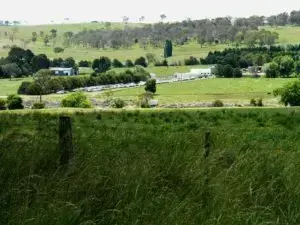
Shannon Vale Station
Shannon Vale Station is a gently undulating property with five kilometres of frontage to the Mann River. It is a remnant of a 250,000 hectare estate allocated in the 1820s to an officer of the New South Wales Corps, after whom the river was named. Following fragmentation and many changes of ownership and use, Greg and Sally Chappell acquired the property in 2001.
Due to the high elevation of around 1000 metres, summers at Shannon Vale are mild and winters cold; temperatures can drop down to minus 17 degrees Celsius and snow is common. Soils are transitional and weathered granite sand to sandy loams; these are poorly structured, highly erodible and have a high rate of leaching so that nutrients can be lost quickly.
Today, Shannon Vale Station comprises a total of 1450 hectares and is managed solely to breed Angus bulls. Bull breeding presents unique requirements for farm management. A high rate of weight gain must be maintained at all times so that bulls reach market weight within 24 months, while stocking rates must allow for the paddock space required to minimise interaction between the bulls.
However it was other challenges that the Chappells were initially up against upon taking ownership of Shannon Vale.
Changing Practices
THE WEEDS TELL A STORY
By the time the Greg and Sally bought the property it had been subject to many years of a conventional annual superphosphate and nitrogenous fertiliser program and regular pasture improvement. Pasture improvement consisted of using herbicide to eliminate all species already present, complete cultivation, addition of superphosphate and nitrogenous fertilisers and then sowing with preferred pasture species, which were mainly annuals. Set stocked grazing management was used. Some areas had been used to grow corn, potatoes and other crops, however the light granite soils of the property were not really suited to sustaining such high nutrient-requiring crops.
The initial efforts of Greg and Sally were focused, within the day-to-day management of the property, on improving measured carcase trait performance of their product lines, the Dulverton Angus and the Currawee crossbreds. The attempts to provide all-year-round nutrition to this seed stock enterprise were based on the standard agronomic approach to farming in that region: weed knock down chemicals, cultivation to prepare seed beds, application of nitrogenous and phosphatic fertilisers and use of annuals such as Italian rye, oats and soy beans in rotation.
The use of the standard agronomic approach and a decade of drought resulted in the seed stock not realising their full genetic potential in regard to growth to sale weight over time to maturity and the expected 90% weaning rate of the cows. It became apparent to Greg and Sally that their pastures were not delivering adequate protein and energy and that digestibility was poor.
Besides the production issues, the combined effect of pasture management, cropping practices and climate led to large tracts of the property becoming completely dominated by weeds. As Greg and Sally say, “The weeds won”.
…we were in a cycle of dependence on inputs to sustain and prop up the production that was not economically viable.
The most problematic of the weeds was African lovegrass, which has negligible nutritional value and which effectively shuts down production of palatable pasture species by blocking sunlight and access to nutrients and moisture. This grass was so pervasive that 80-100% of each paddock would return to African lovegrass after pasture sowing. The pastures were lasting two to two and a half years after each conventional pasture renovation cycle but it was taking three to three and a half years to recoup the cost of renovation. The Chappells explain, “It became necessary to spray out [with herbicide] and start again before the economics made it pay. Hence we were in a cycle of dependence on inputs to sustain and prop up the production that was not economically viable”.
Topsoil was being lost to sheet erosion caused by rainfall on bare soils across the property, and river banks were eroding due to cattle traffic. Organic carbon levels were falling, which reduced water-holding capacity and increased sensitivity to drought. The property had become dependent on high cost inputs of fertilisers and other chemicals, and in addition, grain that cost $500 a tonne was needed to sustain weight gain on the bulls.
Despite all the costly inputs, the weeds were taking over, productivity was declining and the business was going under. Greg recalls, “The majority of gross margin achieved in the sale of production was consumed in the maintenance of pasture production”.
At this point, Greg and Sally came to the realisation that weeds flourish in poor soils and that the structure, chemistry and biology of the soil, and soil health in general, needed attention.
Greg recalls, “The decade of drought made it increasingly obvious that the production system overlaying our landscape was brittle. It was not sustainable beyond short term props from seed, chemical, drench, fertiliser, drugs! In 13 years as an Ag Teacher and 20 years as a grazier we came to acknowledge the importance of the biological and physical components of the system in addition to the chemistry”.
In terms of the decision to change, Greg notes, “[It was] drought and economic viability primarily, with deeper understanding of biological cycles, role of floral succession, potential for beneficial grazing impact on landscape. Reappraisal of practices and enterprise viability led to a decision to act”.
Soil Management
OIL AS THE WEED SOLUTION
From 2005, the traditional pasture renovation program based on synthetic fertilisers, herbicide and cultivation was totally abandoned and replaced with one based on planned grazing, use of organic fertilisers and no soil disturbance. Greg and Sally sought advice from local consultants on pasture management and nutrition and compost production.
Greg describes, “We have, since 2006, embraced the biological approach. We are rebuilding soil structure by increasing the organic and carbon content of the soil. Our research has indicated that for each additional 1% of carbon stored in the soil, we are able to improve the water holding capacity by 144,000 litres per hectare on an annual basis. To date we have increased our soil organic carbon content across our 11 monitored sites. This increase equates to an additional water holding capacity of 120,000 to 150,000 litres per hectare, on an annual basis.”
Additional water holding capacity is important. Although annual rainfall averages between 750-850mm, in recent years it has ranged from 544.5mm in 2002 to 1078.5mm in 2011.
IMPROVEMENTS TO SOIL FERTILITY
| Year | 2002-06 | 2008 | 2011 | 2012 |
|---|---|---|---|---|
| Soil Organic Carbon | 1.00% | 1.46% | 1.44% | 1.47% |
| Phosphorus [Colwell] | 31ppm | 34.5ppm | 32.2ppm | 40ppm |
| pH Range | 4.7 – 5.3 | 5.1 – 5.7 | 5.85 – 6.43 | 5.84 – 7.16 |
| Average pH | 5 | 5.4 | 6.5 | 6.47 |
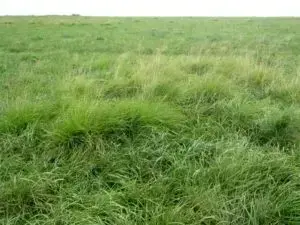
Lush pastures have returned to Shannon Vale, assisted by the improved soil health
Greg and Sally point out that soil health underpins their whole operation. “We have embarked on a course of putting emphasis on soil health and, in doing so, improving our pasture productivity. However, we don’t compromise our animals. Our business success depends on those animals achieving the key performance indicators for growth to maturity.”
In the rejuvenation of their soils and pastures, the Chappells use techniques that include:
- applying compost
- mulching existing pasture stubble
- rotational grazing
- sod seed/direct drill seed
- strategically timed foliar nutrition sprays to increase feed quality or quantity
FERTILISER APPLICATION & VEGETATION
“Other than for spraying blackberry patches, no herbicides have been used on Shannon Vale for approximately six years. Basically, we changed from synthetic fertiliser to a manure-based compost, being differentiated from others by having additional trace elements or macro nutrients added to round it out to a complete fertiliser which best matched our specific soils. This was not possible with conventional granular fertiliser. Where needed, we add pasture seed into the compost for broadcasting in place of cultivation.”
We have managed to create the environment required for succession to allow dormant seed to re-emerge and compete with the weed species.
The organic fertiliser used on Shannon Vale is derived from composted feedlot wastes to which macro nutrients and trace elements are added. The nutrients and trace elements added are based on plant analysis. Using sap analysis as well as plant tissue analysis ensures that short term and longer term deficiencies are identified. Plant sap analyses reveal short term nutrient deficiencies, which can be redressed immediately with foliar liquid fertilisers. Plant tissue tests of pasture mineral levels and quality confirm longer term trends in nutrient flow into the plant and how that affects animal performance. The fertilisers used therefore rectify specific soil fertility deficiencies in each paddock. Both tests are important for maximising pasture growth which enables year-round weight gain on the bulls.
The organic fertiliser is spread at a rate ranging from 300 to 600 kilograms per hectare, according to need.
The foliar fertilisers used generally include the nutrients missing in the plant tests. These are, in effect, like a stock feed supplement for plants, in that they have protein, energy and minerals to generate a plant response over and above nutrient alone. These are applied with the assistance of the Chappell’s consultant and are based on the growing environment and soil and plant data (e.g. as presented in the table below). This fertiliser is applied with water to total 50 to 120 litres per hectare and triggers a response when carrying capacity or feed quality needs to be increased quickly. Greg explains, “Measurements have been taken of pasture feed quality and quantity, to identify the benefit of triggering a plant response from judicious foliar nutrient. This allows us to achieve increased daily weight gain in animal performance and hence achieve target weights sooner, which results in longer rest periods”.
PLANT TISSUE ANALYSIS
| Year | 2011 | 2012 | |
|---|---|---|---|
| Nitrogen % | Average | 3.7 | 3.8 |
| Range | 3.13 – 4.15 | 3.05 – 4.17 | |
| Phosphorous % | Average | 0.34 | 0.36 |
| Range | 0.31 – 0.37 | 0.31 – 0.43 | |
| Potassium % | Average | 2.4 | 2.91 |
| Range | 2.03 – 3.00 | 1.85 – 4.24 | |
| Sulphur % | Average | 0.24 | 0.22 |
| Range | 0.18 – 0.27 | 0.17 – 0.27 | |
| Calcium % | Average | 0.99 | 0.85 |
| Range | 0.78 – 1.38 | 0.56 – 1.02 |
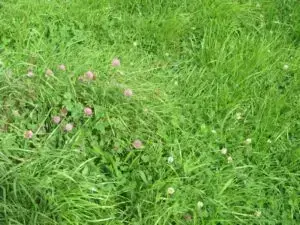
Red clover (Trifolium pratense) has become ‘naturalised’ on Shannon Vale.
Most pasture rejuvenation has been achieved by providing the growing conditions required for previously sown species to become re-established. Nutrient cycling, coupled with a more thorough understanding of species succession, have contributed to a more biologically friendly outcome in healthier soils enabling a more productive all-round pasture base.
In only two years, paddocks dominated by African lovegrass have become substantially re-established with high quality pasture species that have not been sown for many years, in some cases since the 1990s.
Where they have not returned naturally, seed of preferred pasture species is added to the compost fertiliser and some paddocks have been direct drilled, without herbicide. Greg points out, “We no longer get bent out of shape by the presence of so-called ‘lower order’ weeds, such as rat’s tail, sorrel, yorkshire fog, dandelion, etc. We see these for what they are, indicators of poor soil health. We use the production from these species to help build soil organic matter and therefore soil capable of supporting the higher order, more prolific species such as prairie grass, cocksfoot, fescue and clovers. The clovers provide the nitrogen capable of sustaining higher levels of quantity and quality of prairie grass, cocksfoot and fescues”.
Trees are necessary for stock shelter in the cold climate of the northern tablelands and also play an important role on Shannon Vale. The original eucalypt tree cover had been reduced to a sparse cover, mostly on the higher slopes and ridges. Trees have since been established in blocks on high points and in shelterbelts along fences and tracks to provide shelter against cold temperatures often exacerbated by wind, frequent frosts and occasional snow falls. Establishing tree belts is also contributing to increasing biodiversity on the property.
GRAZING MANAGEMENT
Greg points out that their livestock management has been adjusted to assist in maintaining soil health. “We use liquid supplements in winter to help with digestibility of standing dry feed. These supplements ensure the cow pads are softer and so able to be buried by dung beetles. The lack of cow pads on the surface helps break the worm cycle and reduce buffalo fly habitat. This means less drenching. We only drench cows once a year and they have developed a workable tolerance to worms, but it is not so easy to combat fluke.” The Chappells rotational graze their stock. This also has the advantage of breaking the worm cycle.
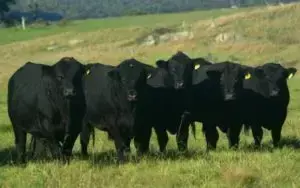
Angus bulls on Shannon Vale.
Subdivision fencing was installed across Shannon Vale to reduce paddock size to increase grazing pressure and allow longer periods of pasture rest and recovery. The productive paddock size is about 14 to 30 hectares. Greg points out, “Reducing paddock size to increase rest and recovery periods must be balanced with the need to minimise stocking rate to avoid social pressures between the bulls”.
Each mob of bulls is now rotated between two to three paddocks. The number of days per cycle is determined by seasonal pasture growth rates and ranges from 26 days in summer to 40 to 50 days in winter. Greg says, “We began, and continue to expand, a practice of rotational grazing, enabling rest and recovery of desirable species throughout the year. Bulls are run in mobs of 40 to 55, that is, one per acre. Our productive paddock size is about 16-24 hectares”.
The Shannon Vale grazing management practices open up the unproductive African lovegrass to sunlight and trigger other species for germination. Greg notes, “Perhaps one of our most notable achievements has being able to reduce the almost total domination of the species, African Lovegrass. Four years ago, we purchased a Schultz 5150 Mk2 slasher/mulcher. We mulched the heavily infested paddocks during the middle of autumn and the middle of spring. The mulching smashes up the lovegrass stubble, leaving it, not in a windrow, as with a normal slasher, but evenly dispersed over the surface of the ground. We mulch a couple of days before removing stock. The herd impact helps compost the mulch and bring it into contact with the soil. The effect is more pronounced if there is rain.”
“This mechanised smashing of unpalatable tussocks leaves residues in contact with the ground, and biological processes, to be decomposed and return minerals to future plant cycle – instead of being tied up within above ground trash indefinitely”, Greg says.
This process is used to substitute for the benefits of high density rotational grazing, which cannot be followed at Shannon Vale as, Greg explains, “Bulls need space to contend with high testosterone social pressure”. This technique also reduces competition, enabling the preferred perennial pasture species, such as fescue (Festuca arundinacea), cocksfoot (Dactylis glomerata), clovers and plantain (Plantago lanceolata), to re-emerge.
Water Management
STOCK WATER
Stock water was previously provided by dams and the Mann River. Greg and Sally place a high value on the importance of the availability of fresh, clean, quality water to ensure optimum growth rates of stock, particularly of calves on cows.
The frontage to the river has now been fenced off and an off-stream watering system comprising pumps, tanks and a gravity fed reticulated supply to a trough in each paddock is continuing to be developed. At this point, all bull growing cells have reticulated water.
Greg notes, “The stock therefore have access to higher quality water and river bank erosion is reduced. Fencing off the river has reduced weeds, because weeds deposited in riparian areas by floodwater are no longer spread into the paddocks by cattle”.
“The reticulated system has had the added benefit this spring and summer of assisting in our controlling bloat by our adding bloat oil to the trough.”
FINANCING INFRASTRUCTURE
Our soil health approach saves about one third of the amount we spent on conventional pasture establishment… and our new approach provides a better all round outcome.
Installing reticulated water is expensive, but the Chappells have been fortunate to receive financial assistance in fencing off their 5.2km frontage to the Mann River. This has not only prevented stock damage to stream banks but has excluded stock from riparian zones so that these areas have more potential for regeneration. Twenty-five per cent of the $100,000 required for the fencing and water supply system was provided under a grant from the Northern Rivers Catchment Management Authority, under their River Reach Program for the Mann River. This program sought to reduce bank erosion and pollution to improve riparian environments and water quality for aquatic fauna and downstream use.
The input costs for infrastructure have been offset to a considerable degree by savings gained through ceasing cultivation, the use of chemical fertiliser and other costs associated with sowing annual pastures. Whilst transfer of some input costs to subdivision fencing reduced the overall capital requirement, Greg and Sally note that, “providing reticulated waters have been a capital constraint to faster implementation”.
Overall, however, Greg says, “Our soil health approach saves about one third of the amount we spent on conventional pasture establishment… and our new approach provides a better all round outcome.”
Outcomes
Robust Results
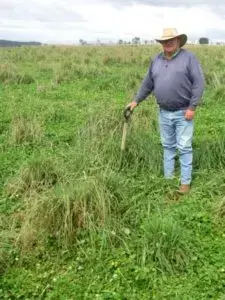
A Shannon Vale pasture after three days grazing
Greg’s and Sally’s approach to land management has eliminated the need to periodically renovate pastures. Complete ground cover is maintained at all times, soil condition is improving and carbon content is increasing. Costs have been reduced on Shannon Vale while production has been increased – the family business is now viable. Greg and Sally point out, “Our guiding principle has been to regenerate the landscape to its potential, whilst not compromising the high standards and output of the business, the breeding enterprise”.
The majority of the farm can now boast diversity of species within the pasture, including legumes, herbaceous species and perennial grasses, which are increasing year by year, even though they have not physically been brought onto the farm in at least six years and in many cases more than ten years.
“We have managed to create the environment required for succession to allow dormant seed to re-emerge and compete with the weed species.”
Diversity and density of pasture has increased. Where unpalatable species of lovegrass dominated, desirable perennial pasture species, such as fescue, cocksfoot, clovers and plantain are now well established. Earthworms and saprophytic fungi that help break down organic matter not previously found in the region have become common. Dung beetles are active in breaking down manure, which in turn accelerates decomposition and nutrient cycling, improves soil organic matter content and structure, helps break the parasite worm burden.
The pasture established is now capable of sustaining growth rates in the order of one kilogram a day per bull year round.
Greg tells the story, “Over five and half years we have nurtured a very tired old degraded paddock growing potatoes and corn, back to full productivity. The full succession process has occurred from sorrel, rats tail, cudweed, etcetera, to the bromes, the ryes then the clovers and then to cocksfoot and fescue that were seeded within compost four years ago. The pasture established is now capable of sustaining growth rates in the order of one kilogram a day per bull year round”.
Dependence on ration supplement to achieve sale weight for the bulls in the second winter after practices were changed decreased significantly with increased grass production and subsequent stock weight gain. Stock feed purchases had reduced to less than half by about three years into the pasture improvement program.
The Chappells are clearly proud of their results, “Cost of production has reduced by 30 to 35 per cent and overall production has increased in the order of ten per cent, excluding the most recent six months, which was an above average season. The last year is up 20 per cent on overall production for bulls and heifer weight gain on earlier averages”.
The results of the new approach taken by Greg and Sally can be seen in the bull growth figures over the past two years (see below). Given that the genetics of the Angus herd have been stable over the past two years and management of the herd has been identical over the same period, Greg and Sally attribute growth statistics to soil and pasture outcomes.
BULL GROWTH
| 2011 | 2012 | Difference | |
|---|---|---|---|
| Number of Animals | 61 | 54 | |
| Growth (Kg/day) | 0.96 | 1.11 | +0.15 |
| Rump (P8) & Rib Fat (mm) | 3.4 – 2.8 | 5.9 – 4.7 | +2.5 – 1.9 |
| Eye Muscle Area (EMA) cm2 | 84.3 | 98 | +13.7 |
| Intra-muscular Fat (%) | 4.7 | 5.1 | +0.4 |
| Scrotal Circumference (cm) | 37.8 | 40.3 | +2.5 |
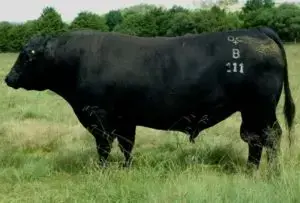
‘Dulverton Blaster’ – a whole lot of bull.
In 2011, their top-priced bull sold for $15,500. The average price across the 67 bulls sold was $6,700.
Numerous Catchment Management Authority, industry and Landcare sponsored field days have been held on Shannon Vale to help communicate the principles and changes taking place and that are continuing. Greg and Sally regularly receive requests for visits from industry types, growers and the like and are content to share their lessons in landscape management and weed control.
MANAGEMENT GUIDELINES & LESSONS
Correcting mineral imbalance takes time. It is not all about phosphorus and nitrogen alone, the other nutrients are also critical.
Greg and Sally have kept records at pasture monitoring sites prior to change for later quantitative comparison. They have found however, that, “Testing, measurement, recording and analysis to determine how we are going and where we will end up, is time consuming and costly”. Learning when to start and stop trials, particularly with their region’s climate also provided challenges to Greg and Sally in implementing their innovations. The lack of local research on species selection for agronomic suitability to balance nutrition was also problematic. However, trial and error, and accessing assistance outside the local mindset has helped Greg and Sally to succeed. They have learnt, “There is not a black and white recipe to the farm. Being an ecosystem it requires flexibility and constant review”. Greg and Sally are adamant that, “Progress has also come from surrounding ourselves with a committed and knowledgeable team. Their assistance, amongst others including our two immediate neighbours, continues to be integral”.
Apart from their personal management guidelines (below), the Chappells understand that flexibility is essential in achieving results, and consequently their management approach is not a static model. Ongoing learning is constant, and they continue to develop the details of their approach once they are confident that their principles are sound. Some of their key lessons include:
- “Trust that species succession will happen if the environment is right for the species you want.”
- “Correcting mineral imbalance takes time. It is not all about phosphorus and nitrogen alone, the other nutrients are also critical.”
- “Grazing pressure is critical. The focus needs to be on the grazing pressure the paddock needs balanced with the animals needs, not just picking a number for want of a simple recipe.”
Management Guidelines
Greg and Sally follow a number of guidelines to achieve the results gained on Shannon Vale. In managing their property, Greg and Sally do not allow:
- bare ground
- cultivation – direct drilling is used if necessary
- grazing without a planned recovery period for pasture
- use of chemical herbicide, except for spot spraying of blackberries
- funding with debt, “We transfer costs from less efficient inputs or increased production”.
- compromise on the profit drivers, that is, the livestock
Overall Greg and Sally are proud that their business has expanded in scale and structure and achieved capital improvement to the asset. But they note that the journey is not over, “We are not at Utopia; we are still learning and will continue to do so”.



